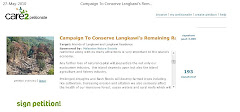The storm clouds were approaching fast before the start of the operation and Langkawi folks had already gathered at Kuala Cenang jetty awaiting the VIPs.
As usual, the VIPs were late and the leader of the pack, Pak Man went ahead and started the briefing before their arrival. Pak Man was a representative from KPSP (Kumpulan Pengurusan Sumber Perikanan) of Langkawi who helped organised the fishermen and their boats in this operation and as well as an advisor to all of us. Since there were no marine experts, Pak Man was our only source of information for the jellyfish habitat and behavior. He seems to be the experienced one.
Pak Man shared his knowledge on traditional treatment on a jellyfish sting. Rub the banana peel over! That will relieve the pain. I don't know what is the rationale behind this, however, this is from the experiences of our fishermen. They are the ones out there and experienced ones besides the marine experts. Pak Man cautioned us all that we must never ever pour tap or mineral water over the sting.
More than sixty people turned up for this event and it was a good number. There were hotel staff, jet ski operators, tour boat opertors and government agencies such as the police and bomba (Fire Department). The operation kicked off about 11:30am after the arrival of the VIPs. The boats headed out to Cenang Beach and we scout the area between Pelangi Beach Resort and Underwater World.
Scooping nets were used
One of boat with the special net equipment
A jet ski cruising past some swimmers while keeping an eye on jellyfishes to be scoop out
JPA (Jabatan Pertahanan Awam)/Civil Defence Department
The boat with the special net
Scooping out a jellyfish
Our first jellyfish scooped out
Good thing about today's weather which was drizzly and cloudy after the downpour. However, the visibility of the water was very poor, about less than 5m. The operation stopped after 1pm for a break before continuing after 2:30pm. While back to Kuala Cenang, all the harvest were gathered together.
A bucket full of brown jellyfishes (no idea of its species). This type of jellyfish is the most common one found here.
Pak Man picked up a jellyfish (ampai-ampai in Malay) and according to him, this is the most dangerous one among all. This one was scooped out by the boat with the special net. Unidentified species, therefore I would call it as the notorious one.
The notorious one in the aquarium.
Part of the notorious one's tentacles stuck within the fishing net.
Tentacles at close up
Pak Man demonstrating tentacles is harmless on the palm but NOT on the other side of the palm.
Please don't try this at home!
Another unidentified species of a white jellyfish caught in an aquarium
Leaders of the pack during the press conference: Pak Man (left) and Osman (right). Osman is our representative for Malaysian Nature Society Langkawi. Kudos to them!
More than hundred jellyfishes scooped up, big and tiny ones. We questioned how such operation would be effective and will that clean up our seas here. Such operation will not clean up the jellyfishes for sure. At least, such operation would create awareness among the locals and tourists. The most important of all, we must know what sort of jellyfish species in our waters here. Next objective is to proof the existence of box jellyfish with the involvement of the locals and authorities.
We were glad to have the fishermen came together to assist. They are the buddies of the marine experts.
We were glad to have the fishermen came together to assist. They are the buddies of the marine experts.
... Read full post ...






























